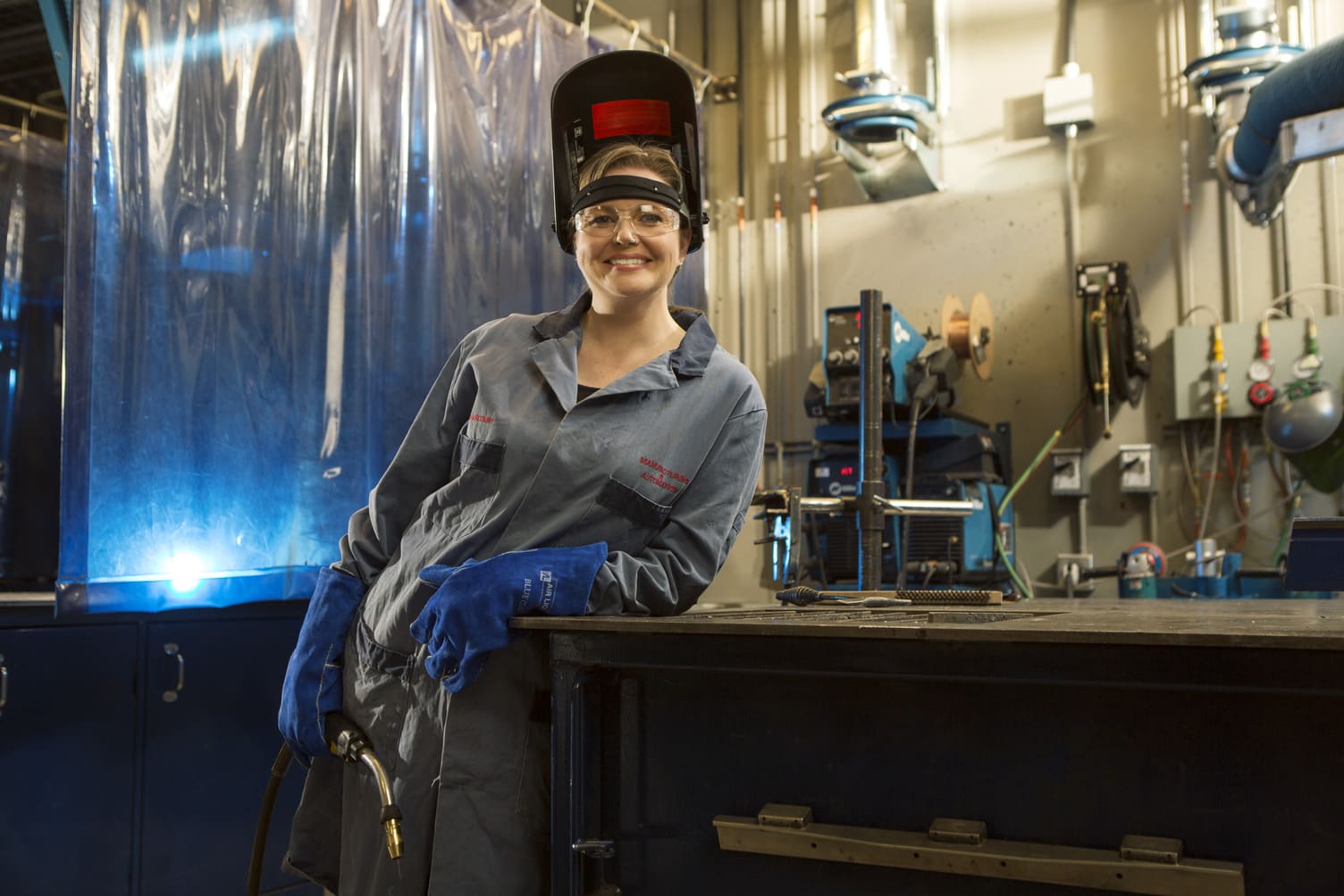On this page:
Overview
Learn to repair, overhaul and maintain agricultural equipment, including tractors, tillage, seeding, and harvesting equipment.
If you enjoy precise work, problem-solving and working with your hands, you'll enjoy a career as an agricultural equipment technician. SAIT offers apprenticeship education for periods two and four.
You may specialize in service and repair of fuel injection pumps and injectors, engine overhaul, hydraulic systems, power shift transmissions or specific types of equipment (combines, forage harvesters, tractors, etc.).
In general, you'll:
- service and repair engines, transmissions, hydraulic systems and the electrical and electronic systems of agricultural equipment
- pinpoint problems by discussing equipment operation with owners
- visually check and listen to machinery in operation
- use testing equipment
- take defective units apart and repair or replace broken, worn-out or faulty parts
- reassemble, adjust, lubricate and test repaired units
- assemble and adjust new agricultural equipment
- learn and apply precision farm technologies such as automated steering systems.
Agricultural equipment technicians must keep up-to-date with new developments in the agricultural equipment field.
Agricultural equipment technicians are skilled tradespeople who are self-motivated and enjoy diagnosing various complex mechanical, hydraulic and electrical problems. This line of work is most fulfilling for mechanically inclined people who enjoy working with their hands.
To succeed in this trade, you should:
- have mechanical ability and good hand-eye coordination
- have the strength required to lift heavy machine parts
- be able to read and understand technical information
- be able to work independently with little supervision
- have emath, communication and computer skills
- have effective interpersonal skills to meet the challenges of the workplace
- be committed to maintaining safe work habits.
Upon successfully completing the required working hours and technical training periods, you'll be awarded an advanced diploma in addition to journeyperson status by Alberta’s Apprenticeship and Industry Training.
This is a Red Seal Endorsed trade – a recognizable standard that allows tradespeople to work across Canada.
Careers and opportunities
Associated National Occupational Classification (NOC) codes: 72020, 72401.
Apprenticeship training
The term of apprenticeship for an agricultural equipment technician is four years (four 12-month periods), including a minimum of 1560 hours of on-the-job training and eight weeks of classroom instruction each year.
SAIT only provides classroom instruction for periods two and four.
Year 2 | Period 2
You'll learn about engine fundamentals, service and repair, engine systems, diesel fuel injection systems, electronics, fuel management, heavy-duty charging and cranking systems.
Training length: 8 weeks
Year 4 | Period 4
You'll learn about hydraulics level two, steering and suspension systems (specific to off-road), accessories (specific to off-road) and powertrain (specific to off-road).
Training length: 8 weeks
Apprenticeship education performance
You must pass each section of the course and the AIT exam to succeed in apprenticeship education.
The passing grade for each period is no less than 50% in each course, with no less than a 65% average overall. A passing mark on each provincial exam and the interprovincial qualification (Red Seal Exam) is 70%.
View Alberta's Apprenticeship and Industry Training procedures
Training pathways
You can earn your journeyperson designation in the following way.
The traditional training pathway begins with finding a job with an employer willing to indenture you as an apprentice. Once you are an apprentice, you will alternate between on-the-job training and educational periods.
You must apply for an apprenticeship through Alberta Apprenticeship and Industry Training before attending your first education period at SAIT.
Admission requirements
To enter an apprenticeship, you must have the educational qualifications required or recommended education for the trade to which you apply.
Entrance requirements are monitored and set by Alberta Apprenticeship and Industry Training.
Minimum requirements
Successful completion of the following courses:
- English 20-2
- Math 20-3
- Science 10
OR
A pass mark in all five Canadian General Educational Development (GED) tests
OR
Passing the Alberta Apprenticeship and Industry Training entrance exam.
Recommended requirements
Apprentices with an Alberta High School diploma that includes the following courses:
- English 30-2
- Math 30-3
- Physics 30 OR Chemistry 30 OR Science 30
- Related career and technology studies (CTS) courses

MyTradeSecrets
Once you have begun working as an apprentice, you can attend SAIT to complete your technical training.
You'll register for technical training at SAIT on MyTradeSecrets or you can register by phone.
Transfer agreements
At SAIT, we evaluate post-secondary credit you have previously earned and apply it to your SAIT credential. Explore our formal transfer agreements available for this program.
We can evaluate your prior education, even if we don't have a formal agreement in place.
Submit a transfer credit application
There are no formal transfer agreements currently in place for this program.
Transfer options for graduates
Build on the knowledge you’ve learned at SAIT. The opportunity to advance your education at an accredited post-secondary institution may be available.
🔗 Visit Transfer Alberta search tool for all transfer agreements in Alberta (including UCalgary, MRU and BVC).
If there are transfer agreements with other institutions outside of Alberta, nationally or internationally, they will be listed below.
Thompson Rivers University
- Program name
- Appliance Service Technician
- Available credits:
- 57
Thompson Rivers University
- Program name
- Bachelor of Technology: Trades and Technology Leadership
- Available credits:
- 60
Available intakes
Costs
2025/26 tuition and fees
The following costs are effective as of July 1, 2025.
This is a bring-your-own-device program with a standard computer hardware and software requirement. See the specific requirements on our computers and laptops page.
Books or modules, along with other items for classes, are approximately $600 per period.
We recommend you don't purchase books or modules ahead of time as they might be outdated by the time you attend classes, and they cannot be returned to the Bookstore.
Personal protective equipment (PPE) will be required for the program, which may be an additional cost to apprentices.

Funding options for apprentices
Apprentices get to learn while they earn, but there are still costs to consider. Many resources are available at SAIT and federally to help support apprentices.
Information sessions
Prepare for a strong start in your chosen program or get the details you need to decide your future path.
Our expert staff and faculty are ready to answer your questions and provide information about the following:
- What sets SAIT apart
- An introduction to the program and area of study
- Admission requirements
- Future career paths
- Information on the earning potential and graduate employment rates.
Contact
Have more questions?
Apprenticeship training and registration
Apprenticeship and Industry Training Client Services

Oki, Âba wathtech, Danit'ada, Tawnshi, Hello.
SAIT is located on the traditional territories of the Niitsitapi (Blackfoot) and the people of Treaty 7 which includes the Siksika, the Piikani, the Kainai, the Tsuut’ina and the Îyârhe Nakoda of Bearspaw, Chiniki and Goodstoney.
We are situated in an area the Blackfoot tribes traditionally called Moh’kinsstis, where the Bow River meets the Elbow River. We now call it the city of Calgary, which is also home to the Métis Nation of Alberta.
